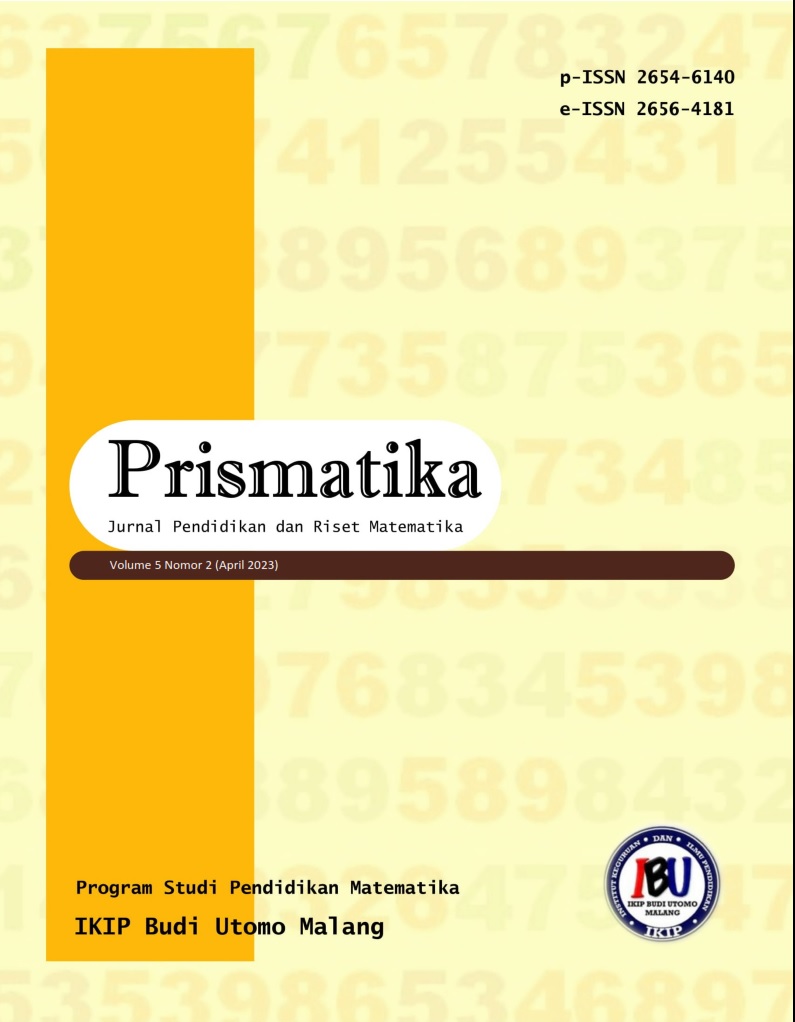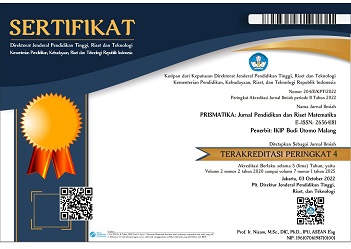PENGARUH STRATEGI BERHITUNG (DIFFERENT STRATEGIES) PADA MATERI OPERASI BILANGAN BULAT TERHADAP HASIL BELAJAR MATEMATIKA
Abstract
This study aims to show the effect of counting tactics that will occur when students study student mathematics. The method used in this study used a quasi-experimental method with a research design of Two Group Randomized Subject Posttest Only. Research activities at SD 4 Panggungrejo Kepanjen were carried out from 16 August to 5 October 2022 for second-grade students at SD 4 Panggungrejo Kepanjen. The sample used was 17 students in 2A grade as the experimental class and 20 students in 2B grade as the control group. The research instrument used was a learning achievement test. The research instrument used was a learning achievement test. The data analysis technique in this study used the t-test to test the proposed hypothesis. The results obtained were counted as much as 0.606 and then consulted using a significance level of 0.05 and 35 degrees of freedom obtained a ttable value of 1.6897. The value of tcount < ttable (0.606 <1.6897) then H0 is accepted, as a result there will be no disparity that will occur in students' mathematics learning between classes taught with arithmetic strategies compared to students with techniques using traditional algorithms. In conclusion, there is no effect of learning the art of arithmetic management on students' mathematics learning outcomes.
References
Andi, G. 2010. Pembelajaran Karakteristik Pembelajaran Matematika. Dalam http://andinurdiansah.blogspot.com/2010/10/karakteristikpembelajaran-matematika.htm
Alifah, S. 2021.Peningkatan Kualitas Pendidikan Di Indonesia Untuk Mengejar Ketertinggalan Dari Negara Lain. CERMIN : Jurnal Penelitian. Halaman 116-123
Asrivi, dkk. 2017.Penerapan Standar Kompetensi Lulusan Mata Pelajaran Bahasa Indonesia Sekolah Dasar. Journal of Primary Education. Halaman 257-266
Aprizal, R. 2022.Penerapan Teori Behavioristik Untuk Meningkatkan Minat Belajar PAI Siswa SD Negeri 126 Seluma Kabupaten Seluma Provinsi Bengkulu. Jurnal Pendidikan Profesi Guru Agama Islam.
Harvey, D. & Marilyn, B. 2005. Teaching the Best Practice Way: Methods that Matter K12 (Portland: Stenhouse Publishers). 253-255.
Khaeroni, K. 2015. Ragam Permasalahan dalam Pembelajaran Operasi Hitung Bilangan Bulat di SD/MI. Primary : Jurnal Keilmuan Dan Kependidikan Dasar, 7(2), 187–206.
Napfiah, S. 2022. Analisis Kelutian Siswa dalam Menyelesaikan Soal Penjumlahan dan Pengurangan Bilangan Bersusun. Jurnal Pendidikan dan Riset Matematika. 50-57.
Pusat Kurikulum, Badan Penelitian dan Pengembangan Departemen Pendidikan Nasional. 2013. Standar Kompetensi Mata Pelajaran Matematika SD & MI (Jakarta: Pusat Kurikulum Balitbang Depdiknas). 19
R. Hyde, P. 2005. “Understanding Mathematical Concepts Through Performance Assessment.” Dalam Harvey Daniels & Marilyn Bizar, ed. Teaching the Best Practice Way: Methods that Matter K12. Portland: Stenhouse Publishers. 253-254.
Ruseffendi. 2006. Pengantar kepada Membantu Guru Mengembangkan Kompetensinya dalam Pengajaran Matematika untuk Meningkatkan CBSA, Ed.3. Bandung: Tarsito.
Rosyid,M. 2019. Prestasi Belajar. Malang: Literasi Nusantara. 3-4.
Syahril, F., dkk. 2020.Pengembangan Perangkat Pembelajaran Matematika Menggunakan Problem Based Learning Pada Materi Barisan Dan Deret Kelas XI SMA/MA. Jurnal PRINSIP Pendidikan Matematika. 9.
Van de Walle, J. 2008. Matematika Sekolah Dasar dan Menengah, ed. 6. Jakarta: Erlangga.
Wahyudin. 2007. Strategi Belajar Mengajar Matematika. Bandung: Universitas Pendidikan Indonesia.







.png)




